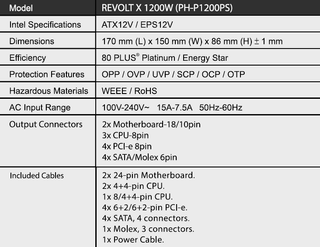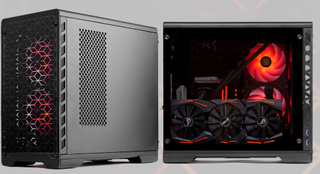Hands On With Phanteks' New Cases and Power Supplies
Phanteks is a brand that so far has focused primarily on PC cases and cooling solutions. We still remember the PH-TC14PE, the first CPU cooler that Phanteks released, and the only one that could go toe-to-toe with the legendary Noctua DH-14, which dominated the air cooling arena back in 2011. But it seems Phanteks wants to expand its presence to other categories as well, starting with power supplies. Entering the crowded PSU market is not the easiest thing to do, but when you have Seasonic supporting you, as Phanteks does, then things are definitely much easier.
Phanteks will start its PSU venture with two lines, the Revolt X and the Revolt Pro.
Revolt X PSU Line





The Revolt X will consist of two members, the PH-P1200PS and the PH-P1000PS. Both are fully modular, 80 PLUS Platinum certified and able to power two systems at once, meaning they will be equipped with two 24-pin ATX cables and will also have three EPS connectors. The 1200W model will have eight 6+2 pin PCIe connectors, so it will be able to power up to four high-end graphics cards at the same time. The Revolt X PSUs switch on when either of the two ATX connectors is triggered, and turn off when neither of them draws any power. Therefore, they can independently power two systems at once, making them ideal for chassis that have room for two systems. Availability is said to start in August 2018, with prices $230 for the 1kW model, and $270 for the 1.2kW unit. The similar capacity Seasonic Prime Ultra Platinum models cost about the same, but they don't come with two 24-pin ATX and three EPS connectors and don't support two systems.So in the dual-PC chassis niche, both Revolt X models look to be a good deal, especially if you take into account their nice design with the aluminum top cover.

Revolt Pro PSU Line




The Revolt Pro will also consist of two members, the PH-P1000GC and the PH-P850GC. Both units are fully modular and 80 PLUS Gold certified. The most interesting feature of the Revolt Pro models is they can be combined with another power supply. This means that you can connect any desktop PSU to a Revolt Pro unit and either combine the total power output of both PSUs, or use the Phanteks unit as a back-up source. According to Phanteks, in dual-PSU configuration the Revolt Pro will continuously balance the power load of both PSUs, in order to achieve the highest possible efficiency levels. This sounds too good to be true, but we're eager to check this feature out with out own equipment once there are review samples available.
The Revolt Pro line will be available in September, with the 850W model priced at $130, while the 1kW unit will cost $150. Based on the pricing scheme, the Revolt Pro units are most likely based on the Focus Plus Gold platform, while the Revolt X models use the Prime Platinum Ultra platform. The chassis for both lines are the same, since different size chassis would increase production costs.

Evolv X







Besides its new PSUs, Phanteks also had several new chassis to show off at Computex, the first being the Evolv X. This is a high-end mid tower case with a $200 MSRP and 3mm sandblasted aluminum exterior, featuring tempered-glass side panels. According to its manufacturer, the Evolv X has vastly improved airflow compared to other chassis and can accommodate up to 19 drives (103.5" drives and 9 2.5" SSDs or laptop hard drives), as well as an E-ATX and an ITX mainboard on the same time, as long as you purchase the optional bracket which allows the installation of the ITX board near the case's roof. There are also integrated fill and drain ports for simplifying the maintenance of the installed liquid cooling systems. Speaking of liquid cooling, the Evolv X supports both 120mm and 140mm form factors (dual 360 or 420+280). There is of course addressable RGB lighting, which is omnipresent in the majority of mid and high-end chassis these days. The Evolv X chassis will be available in August.
Eclipse P600S





The Eclipse P600S is still a work on progress, and according to Phanteks this product will be available somewhere in Q3 of this year. The materials that this case uses includes fabric and sound-dampening sheets. Phanteks informed us that fabric is ideal for keeping the airflow high and being easy to clean. The P600S will allow users to switch between two operation modes: high airflow and silent mode. Lots of attention will be given to silent operation by utilizing sound dampening material everywhere possible, along with rubber seals to minimize vibrations, especially on the side panels. There will be also a pre-installed PWM hub for controlling the case fans. In the storage section the case will support up to ten 3.5" drives and three SSDs.
Stay on the Cutting Edge
Join the experts who read Tom's Hardware for the inside track on enthusiast PC tech news — and have for over 25 years. We'll send breaking news and in-depth reviews of CPUs, GPUs, AI, maker hardware and more straight to your inbox.
The MetallicGear sub-brand And The Neo, Neo Micro, Neo Mini And NEO-G Mini Chassis

Phanteks announced a sub-brand, called MetallicGear, through which it will release several affordable products in the future including all its NEO chassis. The NEO line will consist of four members, initially at least. The flagship NEO is a mid-tower case made of an aluminum and steel with a tempered glass side panel. It supports up to ATX mainboard and it has seven expansion slots, while it can accommodate a single 240mm or 280mm radiator. The MSRP is set at $100.
The NEO Micro, as its name denotes, is the micro ATX variant of the line. It has four expansion slots and supports up to 240mm radiators. Its MSRP is $85. The NEO Mini supports mini-ITX mainboards, and has two expansions slots, while it can take up to 240mm radiators and it will cost $70.

The last member of the NEO family is the NEO-G Mini, which is a modified version of the NEO Mini. The differences between those two models are the front panel's design and the orientation of the motherboard. The NEO Mini features a conventional vertical orientation, while the NEO-G Mini's design allows the mainboard to be installed horizontally on the case. Finally, the NEO-G Mini has one additional expansion slot than the standard NEO Mini, and will cost $10 more.
Aris Mpitziopoulos is a Contributing Editor at Tom's Hardware US, covering PSUs.
-
DookieDraws I don't understand why Phanteks doesn't offer optional front and top panels for their cases, especially for the Evolv cases. Some of us love the look of the Evolv cases, but would prefer better ventilated front and top panels. I would love to see a mesh front and top panel for these cases.Reply
I have the Enthoo Pro, and it's a great case case for the money. -
ubercake Reply21067231 said:I don't understand why Phanteks doesn't offer optional front and top panels for their cases, especially for the Evolv cases. Some of us love the look of the Evolv cases, but would prefer better ventilated front and top panels. I would love to see a mesh front and top panel for these cases.
I have the Enthoo Pro, and it's a great case case for the money.
The Evolv X is supposed to be better ventilated than the standard Evolv. It's one of the things reviewers highlighted about this case at Computex. -
DookieDraws Reply21067516 said:21067231 said:I don't understand why Phanteks doesn't offer optional front and top panels for their cases, especially for the Evolv cases. Some of us love the look of the Evolv cases, but would prefer better ventilated front and top panels. I would love to see a mesh front and top panel for these cases.
I have the Enthoo Pro, and it's a great case case for the money.
The Evolv X is supposed to be better ventilated than the standard Evolv. It's one of the things reviewers highlighted about this case at Computex.
Yes, it's supposed to be, and hopefully it is. They're very nice looking cases, including the original Evolv. -
ubercake Reply21068401 said:And yet, it still looks severely limited. Given competition.
Not sure how it's severely limited. Can accommodate large air coolers, many liquid-cooling configurations, something like 19 drives (has mounts for around 9 SSDs behind the motherboard tray), SSD storage is on panels behind the mobo tray. You're lucky if other mid-tower cases have mounts for 3 SSDs anywhere in the case. The thing uses space pretty well while allowing for a lot of different configurations all within a mid-tower size.
I'm curious to see Tom's temperature and noise tests with this case. It looks great on paper.
Most Popular


